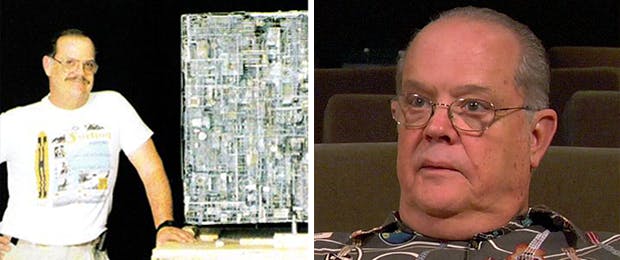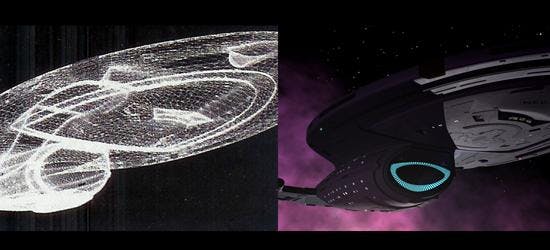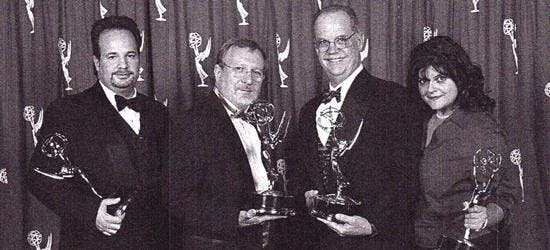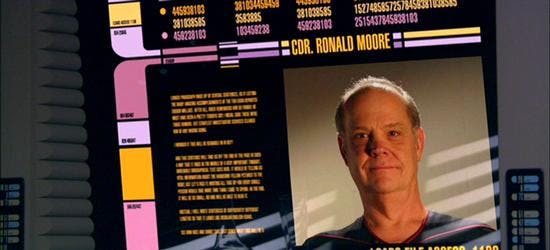Published Oct 1, 2014
INTERVIEW: Emmy Winning VFX Artist Ronald B. Moore, Pt. 2
INTERVIEW: Emmy Winning VFX Artist Ronald B. Moore, Pt. 2

Ronald B. Moore can make a very rare claim – actually, a couple of them. Not only is he a five-time Emmy Award winner, but he’s one of the few people who belonged to the 18-Year Club, that small group that worked on Star Trek from the beginning of The Next Generation to the end of Enterprise. A visual effects wizard, Moore’s Trek work encompassed Star Trek V: The Final Frontier, Star Trek Generations, The Next Generation, a couple of Trek video games, Voyager and Enterprise; he was not involved in Deep Space Nine. StarTrek.com has wanted to interview Moore for a while now, and with his upcoming appearance at Destination Star Trek 3, which will run from October 3-5 in London, Moore agreed to look back at his days in the Trek galaxy and to fill us in on his current projects. Below is part two of our exclusive conversation; click HERE to read part one.

You started on a bit late on Voyager due to your work on Generations…
MOORE: It is a little harder to come into a show late. If you work on a pilot, you get to know everyone and develop a working relationship. If you come in after that you are the new guy. Even though I had been working for over 7 years on Star Trek, I was suddenly a new guy and it took a bit of work to establish myself. Most of the crew had been on the show from the start, so that helped a lot. During Voyager we were moving away from models and motion control to creating the shots on computers. It was an interesting time. Computers really helped us because shooting models with motion control was very time-consuming – rewarding, but it made it hard to keep on schedule. Dan Curry and I really loved the look of models and were not that impressed with CG at the level we had to work with. David Stipes was another supervisor, and he felt the opposite. Well, he kept at it and finally showed us that it could be made to work. There are advantages to both models and CG. Like anything, there are compromises, but CG kept getting better and is still getting better today.
One night, we were working late on the set on the Astrometrics set. The last shot was a visual effect of the large screen. When they got to the shot, the plan was to set up the blue screen, which was going to take an hour or so. It was late and everyone wanted to go home. I talked to the director and assistant director, and came up with a plan that meant that moving things just a little I could let them shoot without setting up the screen. The assistant director made an announcement that thanks to me we could finish up quickly and get out of there. I hear the voice of Jeri Ryan above all the noise saying “I love you Ron Moore!” How can you not love a night like that?
Enterprise
MOORE: Enterprise was very special. The cast and crew for some reason, probably because of Scott Bakula, just got along wonderfully and it was always a fun set to be working on. Even when the conditions sucked. It was sad that it only lasted 4 years. I think the show was starting to come together in season four and could have done some really great shows if it had run as long as the others. I regret that it didn’t do seven years. On the final day of shooting ,it was a really strange place to be. We were all just hanging around trying to say goodbye to people we worked with for years. It was a sad day.
You were there for all 18 years of the modern Trek TV era. Only a handful of staffers can make that claim. How honored are you to be among them?
MOORE: Being one of the 18-year crew is very special. There is a photo of all of us that were there for all 18. It is indeed a small group. What a fabulous thing to have been a part of. I am honored beyond words.
You started to touch on this, but how did the VFX game change over those 18 years? What could you do by the end of Enterprise that you could not have done at the start of The Next Generation?
MOORE: I like to think that for television, we were pushing the envelope. We started out finishing on two-inch video tape and ended up finishing completely in HD digital. We started out shooting all shows and models on film. We ended up capturing images electronically. When we started, there were many limitations to what we could do in the time we had and with the money we had. By the end of Enterprise we could do almost anything with the only limitation being the budget. So to answer, almost everything we did on Enterprise would have been nearly impossible when we started TNG.
Is there one effect, one scene, one moment that you’re absolutely proudest of? You mentioned “Identity Crisis” earlier on…
MOORE: I loved “Identity Crisis.” There is a scene where Geordi is on the holodeck and removing holographic crewmen one at a time to reveal an alien. This was a complex shot that took a lot of time to get set up right. I enjoyed the work even though it took almost all night! It was a sequence where I had to be involved in almost every shot, and I believe it came out great. It would be much easier today but I would not trade it for the world.

You won five Emmys for your work on Trek. What did it mean to you that your peers recognized your work – and did so so often?
MOORE: Winning an Emmy is something most people will never have a chance to do. It is an incredible honor just to be in the same grouping of the other nominees. To win is unbelievable. I have lost more times than I have won, but it is an honor to be nominated. Another award we were lucky enough to win is a VES Award. This award is from the Visual Effects Society and is very special to me. I was on the board of directors for VES for a number of years.
You were part of a large team. Who were some of the unheralded people you worked with?
MOORE: Dan Curry is an incredible artist. We were partners and it is unbelievable how much I have learned from him. Rob Legato is another artist that works so much differently than Dan or I, but has a unique talent that is remarkable. He has gone on to do amazing work and managed to win an Oscar or two. Gary Hutzel was one of the original team members and the king of motion control. Another I learned a lot from. There were a number of visual effects compositors I had the pleasure of working with. The last was Paul Hill. When we started working with him, he was an assistant compositor and I was able to watch him grow and had the pleasure of asking him to work with me when I needed a new compositor. He jumped right in and we worked together for many years. The shows would have been less (memorable) without him. So many more… Motion control cameramen, computer artists, designers, model builders, tape operators, schedulers. This only scratches the surface. I could go on here, but will stop saying that you have it right. No one person did the work. It was a large team and we depended on each and every one of them.

How big a kick did you get out of playing Commander Ronald Moore in the Enterprise finale and, in general, how amused were you by all the Moore references scattered across the franchise?
MOORE: Who could turn down a shot at being in a Star Trek episode? It was terrific. Had my own uniform! Great day. It was Enterprise, but seemed appropriate that it was a Next Gen uniform. The references are great fun. There are not many shows that would allow for something like that. In TNG, in the episode “The Outrageous Okona,” Data goes to the holodeck to call up a comedian. Originally the plan was for Joe Piscopo’s name to come up. When I was in the edit bay and we were putting the shot together I got a call from my boss. He told me that they had changed their mind and didn’t want us to use his name. So I had the compositor put in my name and shipped the shot out. There was little time left and no time to change it. I think my boss got a kick out of it. But the name stands.
And we guess we should end the conversation with this… How often are you confused with Ronald D. Moore?
MOORE: Usually on a daily basis! It was funny, I recently did a convention and was on a panel with Doug Drexler. The program had me listed as Ronald D. Moore. Ron is a really great guy and I can think of worse people to be confused with. It is strange that now and again someone will come up with a picture of Ron D. and ask me to sign it. Clearly I look nothing at all like Ronald D. Moore. But rather than point it out I just sign it the other Ron. We are forever connected. I hope he has as much fun with it as I do. I told him once that I picked up copies of one of his books and signed them and gave them to friends and that I hoped he didn’t mind. He said he was OK with it, but that he told people he had an Emmy! Funny. I hope he gets one for his new show Outlander, as it is outstanding.
Read part one of our conversation with Ronald B. Moore. And visit www.destinationstartrek for details about the upcoming Destination Star Trek 3 event.

